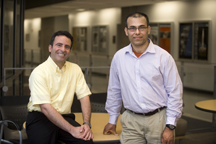Purdue researchers working on missile-defense software
August 12, 2013
 |
|
Daniel DeLaurentis, left, an associate professor in Purdue University's School of Aeronautics and Astronautics, and Saurabh Bagchi, a professor in Purdue's School of Electrical and Computer Engineering, are working with the U.S. Missile Defense Agency to help the United States foil enemy missile attacks. (Purdue University photo/Mark Simons) |
Approved for Public Release, 13-MDA-7340 (10 June 13).
WEST LAFAYETTE, Ind. – Purdue University researchers are peering into the future to help the United States foil enemy missile attacks.
Working with the U.S. Missile Defense Agency, the research team is creating software that makes it possible to pose various "what-if" questions; scenarios that explore plausible future missile advances in adversarial nations and the defensive capability of the United States.
"Our mission is to look into the future, to say, for example, what if we had some new missile technology, or what if a country X had the capability to launch X number of missiles at the United States? What would we have to do to shoot them down?" said Daniel DeLaurentis, an associate professor in Purdue's School of Aeronautics and Astronautics.
The research focuses on how to defend against attacks called "raids" in which many missiles would be launched against the United States, said Saurabh Bagchi, a professor in Purdue's School of Electrical and Computer Engineering.
"The system must be able to handle a raid environment, based, in part, on the assumption that our potential adversaries will expand their missile capabilities in the future," he said. "So we are developing a battle management system that is flexible enough to work for decades from now. The biggest challenge is trying to do decision making under conditions of uncertainty. There is uncertainty about what the enemy will be able to do in the future and what we will be able to do in the future."
DeLaurentis is leading the project with Bagchi, working with Stephen D. Heister, Purdue's Raisbeck Engineering Distinguished Professor for Engineering and Technology Integration, Joseph Pekny, a professor of chemical engineering, two research scientists and about a dozen doctoral students.
The project began in 2010 and is funded with a four-year, $4.8 million grant from the Missile Defense Agency, which is part of the U.S. Department of Defense.
Scenarios included hypothetical attacks by other nations. The United States can launch interceptors from Fort Greely in Alaska and from Navy Aegis destroyers and cruisers equipped with the Aegis Ballistic Missile Defense weapon system. The nation's anti-missile system is designed to locate missiles, track them and launch intercepting missiles to shoot them down.
"The earlier the intercept after enemy missiles are launched, the greater the probability of mission success," DeLaurentis said. "Otherwise, they fan out more and have greater opportunity to further complicate the engagement. Additionally, the closer they get to our friendly positions, the more you have to worry about additional factors like potentially dangerous debris."
The project is inherently interdisciplinary because it requires expertise in aerospace and computer engineering.
"You need aerospace for things dealing with missiles and the operation of satellites, sensors and radars," Bagchi said. "You need computer science and computer engineering to run algorithms that will decide which weapons to fire and at which missiles and also to fend off simultaneous cyber-attacks against our command and control computers."
Specialized software designed for "enhanced command and control" includes algorithms for aerospace modeling of the flight characteristics of enemy missiles and interceptors. The complex software needs to function within a global network of many computers and sensors including radar and satellite surveillance systems. A key challenge is to create algorithms that are able to function in such distributed environments.
The researchers use a high-performance computer cluster provided by Information Technology at Purdue, or ITaP. The project uses intensive long-running simulations, which make it possible to assess the performance of the U.S. missile defense system using as few field tests as possible.
"This is important for several reasons," DeLaurentis said. "Field tests are expensive, so you want to use them sparingly. At the same time the simulations allow us to run many more experiments than would otherwise be possible with field tests alone, and this yields a lot of data to improve the system."
Writer: Emil Venere, 765-494-4709, venere@purdue.edu
Sources: Daniel DeLaurentis, 765-494-0694, ddelaure@purdue.edu
Saurabh Bagchi, 765-494-3362, sbagchi@purdue.edu
